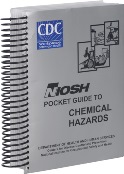NIOSH Developing Free Mobile Pocket Guide
This will make the agency's most popular document a true pocket guide, one commenter observed. NIOSH officials want feedback from users to help them decide how to organize the content.
Donna Van Bogaert, Ph.D., chief of the Information, Resources, and Dissemination Branch at NIOSH, and Glenn Doyle, the NIOSH Web Coordinator, announced on the agency's Science Blog that NIOSH is developing a free mobile web version of the NIOSH Pocket Guide to Chemical Hazards and seeks feedback from users on what to include in it. The guide, NIOSH's most popular document, has been available in print since 1978 and will continue to be, they wrote.
 The Pocket Guide is used by a wide range of workers and managers in training courses and in the field, including during emergency response situations. The current, 424-page edition contains detailed descriptions of 677 chemicals commonly found in the work environment, along with details on exposure routes, recommended PPE, first aid, incompatibilities and reactivities, and much more.
The Pocket Guide is used by a wide range of workers and managers in training courses and in the field, including during emergency response situations. The current, 424-page edition contains detailed descriptions of 677 chemicals commonly found in the work environment, along with details on exposure routes, recommended PPE, first aid, incompatibilities and reactivities, and much more.
"We know many people rely on the printed version, particularly in times of emergency when power may be out or signals down or overextended. The NPG will continue to be available for print. We also know that there is a growing demand for the NPG in a mobile version that could offer users more convenience and flexibility," Van Bogaert and Doyle wrote April 15.
They ask users to post comments -- at least eight commenters have weighed in, all of them welcoming the news -- about these assumptions:
1. A free mobile web version of the NIOSH Pocket Guide (NPG) would be a valuable tool for safety officers, industrial hygienists, emergency responders, and health professionals who treat workers.
2. Most professionals using the mobile NPG will be using iphone, ipad, and Android technologies.
3. Hands-free technology would be an important feature of a mobile NPG.
4. A small mobile device will not be able to show all the NPG fields at one time. The fields most important to show first are: Name, CAS#, Incompatibilities and Reactivities, Exposure Symptoms, First Aid.
5. Not everyone will have the resources to access the NPG mobile version. Other ways NIOSH could make the NPG easier to use might include posting a downloadable EXCEL database. Users could decide which pages and fields to print and eliminate information that wasn't useful in their specific situations.